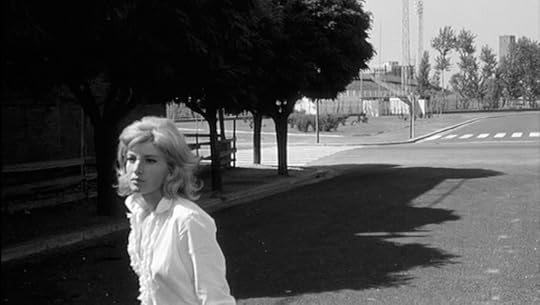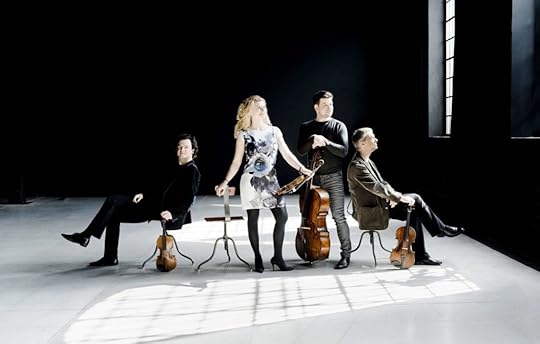Peter Smith's Blog, page 86
November 2, 2016
In another troubled world …
In another troubled world, a young woman – enigmatically beautiful – forever wanders the streets of modernist suburban Rome.
In this equally troubled world of ours, Monica Vitti, who played her so unforgettably, is 85 today.
Which makes me feel rather old.
November 1, 2016
Back to IFL2
There is now, freely downloadable, a revised version of the first part of my Introduction to Formal Logic, the scene-setting chapters on informal logic before the book gets formal. So these chapters from the planned second edition explain a few logical ideas like validity, forms of argument, counterexamples, proofs, etc. Beginning students who want a logical helping hand might well find them useful (so please spread the word to any class that might profit).
A small number of very kind readers have made really useful suggestions that have improved these early chapters a lot. I will be posting shortly about how to get to see more chapters, but I though I would make these early chapters available, hot off the laptop.
October 25, 2016
The Greeks win (2)
On the question of metavariables — relaxed italics versus Greek letters. Which do you prefer? Those who voted in the poll (and too late, I realized I should have had added a “really don’t care” option), preferred Greek letters by 4 to 1.
Not just for that reason, I decided a couple of weeks ago (before my brain was shut down by a cold) to go for Greek letters. And returning now to the decision, yes, that is still what I am going to do.
Or rather, I am going to do something just a bit more complicated — but I hope even better than an always-italics or an always-Greek solution.
In the very early chapters of my logic book where everything is still very informal, arm-waving, motivational, I continue to use talk of patterns of argument like ‘All F are G, n if F, so n is G‘ in that familiar and relaxed philosophy-classroom way which is surely good enough for very introductory purposes. Though I soon point out it is of course arbitrary what we use for placeholders, so long as patterns of recurrence stay the same.
I also then point out quite quickly that it is a bit murky how such informal notation is used (are we representing patterns in the surface form of everyday arguments or patterns in some supposed underlying logical form or what?). We don’t have to worry about this matter much for very introductory purposes (just as we skim over issues about sentences vs propositions, for example).
However, after the half-dozen intro chapters, we very quickly go formal in IFL, saying that we are going to be dealing with everyday arguments by a two-step process: we regiment these everyday arguments into a nice suitable formal language, and then develop tools for assessing arguments in these formal languages. So we quickly find ourselves talking about formal languages and wanting to talk e.g. about patterns of argument in these formal languages — and now I adopt the convention that placeholders/metavariables added to English to help us talk about wffs and other expressions of our formal languages will be Greek letters. And we have a perfectly precise story about what these variables run over (everything is cleanly superficial and syntactic).
So, in short, italic letters used in a loose but good-enough way for relaxed pre-formal use (as in our philosophy lectures when sketching the form of an argument, say); Greek letters are used when we really are talking about formal languages. Neat and perspicuous. No? (Well the proof is in the pudding, but having done some rewriting along this plan, I think it works well!)
The Greeks win (1)
To the Cambridge Greek Play a dozen days ago. Every three years, student actors and a professional directing team put on one or two plays, in the original Greek — this year, a double bill of Antigone (predictably wrenching) and Lysistrata (predictably bawdy and funny) at the Arts Theatre.
And if you think this is bound to be of minority interest, just try to get tickets for one of the eight performances if you don’t book weeks ahead (and if you get tickets, you’ll find yourself in perhaps the most age-mixed audience of any night of the year). There is no attempt to recreate a fake antiquity. The plays are re-imagined, the stagings are modern. In comedies, contemporary references are freely updated, so in Lysistrata, a messenger and magistrate become Donald Trump and Boris Johnson (who end up tap-dancing — don’t ask!). But there is every attempt to get the complex rhythms of the ancient language to sing again (and indeed the chorus does sometimes burst into song), in a way that can be spectacularly effective. Translations-by-surtitles mean you don’t have to rely on dim memories or sneaky glances at the programme, and work brilliantly.
Again, as with the previous Prometheus/Frogs double bill, a fantastic night at the theatre. Creon, who doubled as Donald Trump, and Lysistrata herself were quite outstanding. Though it was just a little sobering to realize that the last time the Cambridge Greek Play did Antigone, a performance that I saw as a schoolboy, was over fifty years ago.
(We thought, though, that we might have been coming down with “a bit of a cold” that evening. And oh heavens, yes. Hardly been able to stir from the house since. Which in my case goes with a woolly brain, and logic not even on the back burner — the light turned right off until today. Apologies to those to whom I promised some revised chapters of IFLs to look at. I hope to get back to light logical duties tomorrow!)
October 15, 2016
“My heart in hiding/Stirred for a bird”

Photo from BBC website
When we lived in Aberystwyth, long since, there was only a handful of pairs of red kites left in the whole of Britain, living in the remote mid-Wales hills. But we would see kites occasionally gliding down the Ystwyth valley, to scavenge on the town tip next to the sea. The birds are now much more common in Wales, and have been re-introduced into various parts of England too with great success. But it was so surprising, the sheer delight to be driving out to a pub near Cambridge along a back way, turning a slight bend in the road, and — not a dozen yards from the car — a kite was swooping to the grass verge, grabbed its lunch, and magisterially flew slowly on.
How stirring such moments still are.
October 8, 2016
The Pavel Haas Quartet at the Wigmore Hall
Another extraordinary concert from the Pavel Haas Quartet last night.
They began with Webern’s Fünf Sätze of 1909 — extraordinarily condensed, emotionally unsettling music, which for me works better in a live performance than it can ever do listening to a recording. Certainly I have never got anywhere as much out of this Webern, as from this characteristically intense but totally controlled performance from the PHQ.
Next, the Shostakovich String Quartet, No. 2. Again, this is unsettling music, emotionally torn and veering from dissonance (even violence — and a resulting broken cello string) to the simply melodic and back. Compared with the couple of recordings I know best, this again was extraordinarily intense playing last night.
Reviewing a recent DVD of Schubert quartets by Cuarteto Casals, Michael Tanner remarks in passing, “One always speculates – at least I do – about the dynamics, artistic and personal, of string quartet performers”. I speculate too. Was it just my romantic imagination, or at the centre of the slow movement of the Shostakovich, when the first violin has a particularly yearning melody set against the background of chords from the others, didn’t Veronica Jarůšková play directly to her husband and father of their small child, the cellist Peter Jarůšek? It was difficult not to feel that.
After the interval, the PHQ were joined by the young Dutch cellist Harriet Krijgh for Schubert’s String Quintet. I think this was the first time that they have performed the piece together in a concert: so the first thing to say is that the ensemble, the stylistic unity, between the five of them was somewhere between superb and miraculous. And as for the interpretation, it is as you would have expected from the PHQ’s award-winning CD (with Danjulo Ishizaka). There was again an overarching sense of the piece as a whole (so not at all one of those performances where the last two movements come as a disappointing let-down after the extraordinary heights of the first two). There was a particularly driven and emotionally taut third movement, so good that it drew premature applause. But, as always in great performances, the slow movement was transcendental: when it finished, the audience sat in total silence, not a murmur, not a rustle, not a cough.
If I am ever again present at a performance of the Quintet as good, I will count myself blessed.
October 4, 2016
How do you like your metavariables?
Ok, logic people: it’s time to vote on a Grave Matter of Great Pedagogic Import!
So here I am, revising my intro logic book — which, recall, is intended for first year philosophers. I try to get things fairly precise, at least when we get down to formal business after the initial informal faffing around, but I also aim to keep things unscary.
I’m still a bit torn about what to use as metalinguistic variables.
In the first edition of my book, I use a sans serif font for wffs in the formal languages, as in:  ,
,  .
.
Then I use serif italic for metavariables, e.g. as in ‘A’, ‘Fn’. Though on the board in class, some years I’d actually use Greek letters for metavariables.
Pro using italics: Familiar italic type makes the book look rather less mathematical, rather less daunting (most philosophers are neither classicists nor mathematicians — so initially
 is about as friendly as ‘squiggle squoggle’).
is about as friendly as ‘squiggle squoggle’).Pro using Greek: It’s the convention in more advanced texts so you might as well get used to it straight away. And for lecturers writing on the board, and for students taking notes, keeping track in your handwriting of ‘ordinary letters’ (for formal languages) vs Greek letters (metalinguistic) is much easier than trying to mark the distinction between e.g. upright and sloping letters.
In writing the first edition, friendliness-on-the-printed-page was the winning consideration. I still lean in that direction. But I’m interested to know what you think. So here is a poll (vote thinking of the interests of likely readers of an intro text!).
Note: There is a poll embedded within this post, please visit the site to participate in this post's poll.
By all means add further thoughts in the comments below, as obviously this is a Very Serious Issue.
September 30, 2016
Munich conferences
I guess my conference-going days are past. But if I were full of youthful zip and enthusiasm, then the conferences run by the Munich Centre for Mathematical Philosophy would be terrifically appealing.
There’s one on Mathematical Structuralism which starts in a couple of weeks (talks should later appear on Youtube). And there is one in January on Model Theory: Philosophy, Mathematics and Language. I guess most readers of this blog with interests in that area will already know about this upcoming conference (for which there is a Call for Papers, whose deadline isn’t yet past). But I’m linking here, just in case you didn’t know about it.
September 27, 2016
A little light medieval logic?
There is a new Cambridge Companion to Medieval Logic just out, edited by Catarina Dutilh Novaes and Stephen Read (all praise, by the way, to CUP for continuing to price the paperbacks of books like this so very reasonably).
The Companion is divided into two parts. The first, ‘Periods and Traditions’, has seven historical essays with titles like ‘Arabic Logic up to Avicenna’ and ‘Logic in the Latin Thirteenth Century’. The second part, ‘Themes’, has eight essays on topics like ‘Propositions: their Meaning and Truth’, ‘Sophisms and Insolubles’ and ‘Consequence’.
Having dipped in and out, skimmed here and there, I’m not sure this is quite the book for me: but your mileage, as they say, may very well vary. As with much writing on the history of philosophy/history of logic, it will depend whether or not your interest is indeed primarily historical. A lot of obscure-to-me figures get name-checked, without inspiring much inclination to find out more. If your attitude like mine is rather ahistorical, if you are hoping to look to the medievals for some good logical ideas either missed or not well developed in current debates, then this is probably not quite the book for you. Certainly, given my ahistorical interests (OK, I’m a philistine), I would have welcomed a book which said quite a bit more about quite a bit less.
For just one example, we are told on p. 317 that the view that from an impossible proposition anything follows “eventually … prevailed”. But we don’t get to know why, or what the contending considerations were. In the same chapter on consequence we are told that Buridan “subsumes under a broader notion of consequence” both, as we would put it,  and
and  . Since we tell our students that assimilating these two is a Bad Mistake, I wanted to know more about how this subsumption plays out, and whether it leads to trouble; or does it e.g. intimate an inference-ticket theory of the conditional? But my questions went unanswered.
. Since we tell our students that assimilating these two is a Bad Mistake, I wanted to know more about how this subsumption plays out, and whether it leads to trouble; or does it e.g. intimate an inference-ticket theory of the conditional? But my questions went unanswered.
Or take the chapter on propositions. We are told that for medieval logicians a proposition is a “type of sentence. i.e. a linguistic expression … singled out by its truth-evaluable character”. But then, to ask the level 101 questions, how did these medievals respond to the arguments (which would be familiar? or wouldn’t they be?) for thinking of the primary bearers of truth and falsity as being not types of sentences but rather the contents of the judgements the sentences can be used to express? Did these logicians, or some of them, end up with propositions-qua-sentences and propositions-qua-Gedanke? If not, why not? If they did, what’s the story to be told? Now, I think I take away from the chapter that there were different accounts on the market — but I really am left very unclear about what they were, how the arguments went.
Which of course is probably just to complain, quite unfairly, that the book is not the one I really wanted, to distract and inspire as I tangle again e.g. with the issues about propositions and consequence that are bugging me as I re-rewrite the very earliest chapters of my logic text!
September 25, 2016
Category theory notes
A reminder and a request.
The reminder is for anyone interested in category theory at an introductory level — whether giving a course, or taking a course. There is a page here of links to online notes and freely available articles and books and even videos. Some have found my own work-in-progress Category Theory: A Gentle Introduction helpful as it is particularly aimed at beginners (note however that this is pretty rough and ready in parts, and very far from finished even as a first draft — but I’m currently distracted by another project!).
And the request? Please do let me know about any useful new additions that could be made to that page of links.





